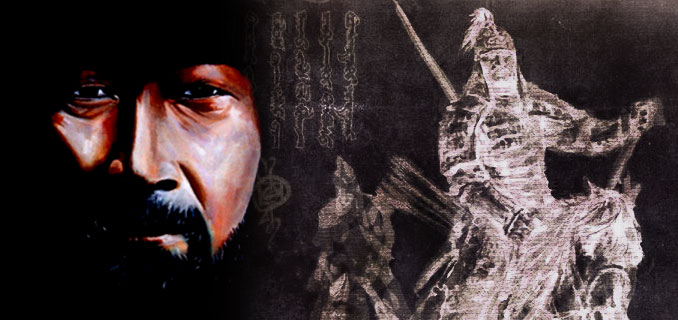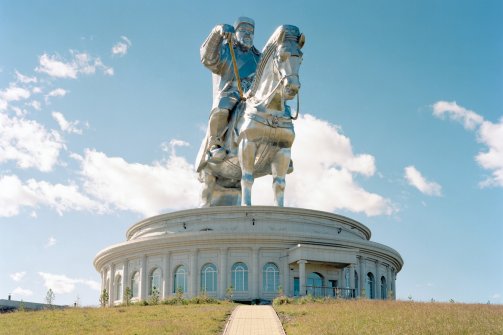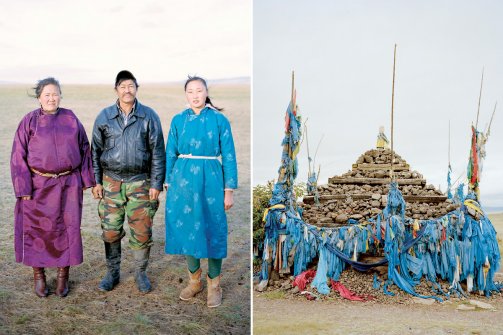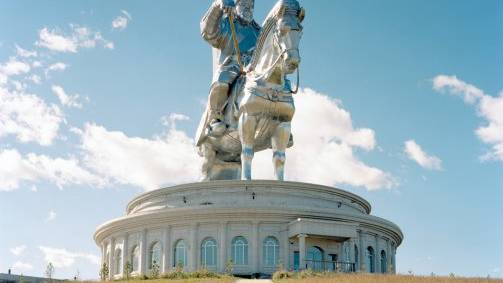The Hunt for Genghis Khan’s Tomb
Source: thedailybeast.com

For centuries historians and treasure seekers have searched for the burial site of history’s most famous conqueror. New findings offer compelling evidence that it’s been found.
In the eight hundred years since his death, people have sought in vain for the grave of Genhis Khan, the 13th-century conqueror and imperial ruler who, at the time of his death, occupied the largest contiguous empire, stretching from the Caspian Sea to the Pacific. In capturing most of central Asia and China, his armies killed and pillaged but also forged new links between East and West. One of history’s most brilliant and ruthless leaders, Khan remade the world.

A 250-ton stainless-steel statue of Genghis Khan outside the capital of Mongolia.
But while the life of the conqueror is the stuff of legend, his death is shrouded in the mist of myths. Some historians believe he died from wounds sustained in battle; others that he fell off his horse or died from illness. And his final burial place has never been found. At the time great steps were taken to hide the grave to protect it from potential grave robbers. Tomb hunters have little to go on, given the dearth of primary historical sources. Legend has it that Khan’s funeral escort killed anyone who crossed their path to conceal where the conqueror was buried. Those who constructed the funeral tomb were also killed—as were the soldiers who killed them. One historical source holds that 10,000 horsemen “trampled the ground so as to make it even”; another that a forest was planted over the site, a river diverted.
Scholars still debate the balance between fact and fiction, as accounts were forged and distorted. But many historians believe that Khan wasn’t buried alone: his successors are thought to have been entombed with him in a vast necropolis, possibly containing treasures and loot from his extensive conquests.
Germans, Japanese, Americans, Russians, and Brits all have led expeditions in search of his grave, spending millions of dollars. All have failed. The location of the tomb has been one of archeology’s most enduring mysteries.
Until now.
A multidisciplinary research project uniting scientists in America with Mongolian scholars and archeologists has the first compelling evidence of the location of Khan’s burial site and the necropolis of the Mongol imperial family on a mountain range in a remote area in northwestern Mongolia.
Among the discoveries by the team are the foundations of what appears to be a large structure from the 13th or 14th century, in an area that has historically been associated with this grave. Scientists have also found a wide range of artifacts that include arrowheads, porcelain, and a variety of building material.
“Everything lines up in a very compelling way,” says Albert Lin, National Geographic explorer and principal investigator of the project, in an exclusive interview with Newsweek.
For 800 years the Khentii mountain range, where the site is located, has been off-limits, decreed thus by Genghis Khan himself before his death. If the findings bear out, this will be one of the most significant archeological discoveries in years. Using drones and surface-penetrating radar, and enlisting the help of thousands of people to sift through satellite data and photographs, the team has searched the mountain range, systematically photographing 4,000 square miles of landscape.
In a laboratory at the California Institute for Telecommunications and Information Technology at University of California, San Diego, Lin and his team combed through the massive volumes of ultrahigh-resolution satellite imagery and built 3-D reconstructions from radar scans in their search for clues to where Genghis Khan may be buried. As part of an unprecedented open-source project, thousands of online volunteers sifted through 85,000 high-resolution satellite images to identify any hidden structures or odd-seeming formations.
“It is undeniable that Genghis Khan changed the course of history. Yet I cannot think of another historical figure of comparable impact that we know so little about,” says Lin, who is still tight-lipped about the full extent of the team’s results as they await peer review. But excitement shines through his academic caution. “Any archeological results related to the subject may shed light on a vital piece of our shared cultural heritage that has gone missing.”
To reach the Khentii mountains, you drive east from the capital, Ulan Bator, passing a shimmering statue of Genghis before reaching the mining town of Baganuur. The crumbling town has all the charm of a post-Soviet Dickensian nightmare: a 10-mile-long slag heap signals the presence of the largest state-run open-pit coal mine in Mongolia. Exiting north out of town, the remains of a Soviet military base bring to mind the set of a post-apocalyptic horror movie. But once free of the city, the Kerulen River Valley, homeland of the Mongols, unfolds in all its panoramic beauty. Located on one of the main east-west routes across Central Asia, the steppe continues west to the Caspian Sea, east to Japan and northern China, circumventing the Gobi Desert that inspired nightmares for Marco Polo and other travelers.
This geography, and the forgiving climate, has made the steppe an attractive place for the nomads to live. Unlike the rest of the country, where temperatures can plummet below minus 40 degrees Fahrenheit and peak above 100 during the summer, the climate in these valleys is unusually mild. Ritual monuments and burial sites are scattered throughout the landscape. Archeologists have found tombs on top of tombs, where different tribes from different eras have used the same ritual space.

Many Mongolian families still live in yurts, maintaining their nomadic lifestyle.
Mongolian families still live in yurts or gers, as the traditional tents are known locally, maintaining their nomadic lifestyle. The blue sky merges with the horizon, and white yurts dot the sweeping landscape like sailboats floating on a sea of green.
From afar, the pastoral herding scene appears to have evolved very little since the Khans ruled. But in fact times are changing for the nomads. A decade of devastatingly harsh winters followed by very dry summers has crippled the livelihoods of livestock-dependent herders, who make up a third of the country’s population. Tens of thousands have migrated into city slums, while thousands of others have turned to illegal gold mining in their fight for survival. Carrying on their backs big green panning bowls for finding gold, they’re known as the ninjas because of their resemblance to the Teenage Mutant Ninja Turtles. At the same time, Mongolia is rapidly developing—in large part due to its mineral riches. By some estimates, Mongolia’s economy is the fastest growing in the world, as the nation seeks to tap its wealth of coal, copper, and gold, projected to be worth $1.3 trillion.
Up close it is clear that even this remote valley is not untouched. A satellite dish and a Chinese-made truck and motorbike sit outside one yurt, where we stop to ask for directions.
Altan Khuyag, a 53-year-old herder and forest ranger, offers us a cup of warm milky tea, insisting that we stay the night, in a typical display of Mongol friendliness. Among the nomads, reciprocal hospitality is a vital part of life on the steppe. When I ask about Genghis, he dips his ring finger into a bowl of vodka, flicking a drop to the sky, towards Tengri, the god of the blue heaven. Two more dips, two more flicks, two more ritual offerings. In Mongolia, superstition still surrounds Genghis Khan, and the hunt for his tomb often stirs heated debate. Even his name is a touchy subject. In Mongolia, Genghis Khan is known as Chinggis Khaan and is considered by many almost a god.
“He watches over us. He is why we have our good lives today,” says Khuyag, hunching his shoulders as if feeling the presence from above. He, like many locals, thinks Genghis Khan is buried on a mountain in the Khentii range—a belief shared by both ancient and contemporary historians but unsupported by science or physical evidence until the discoveries made by Lin and his Mongolian partners.
[...]
Read the full article at: thedailybeast.com






















